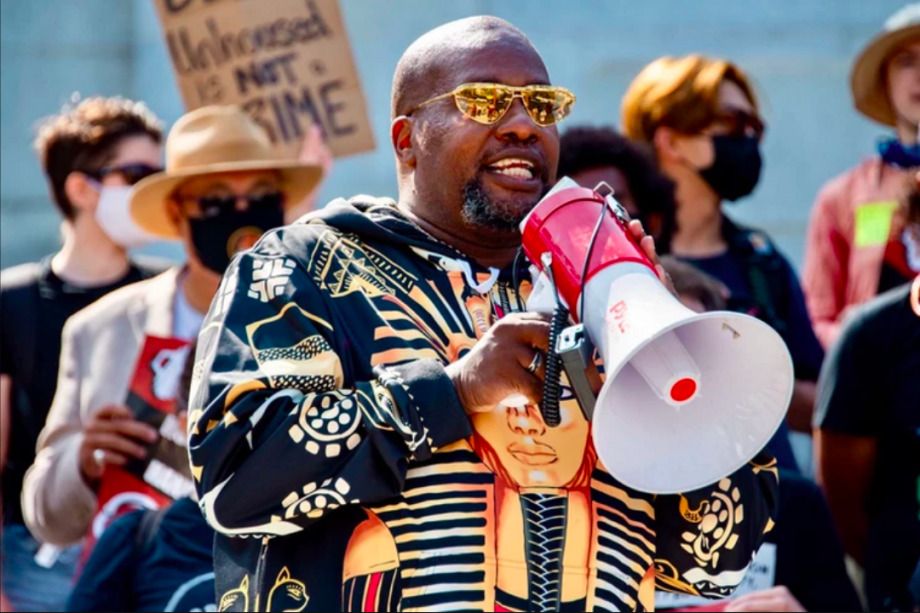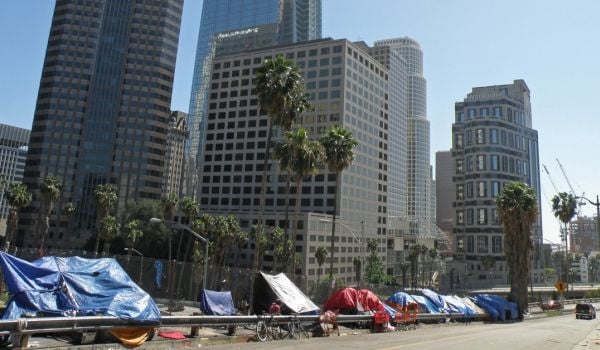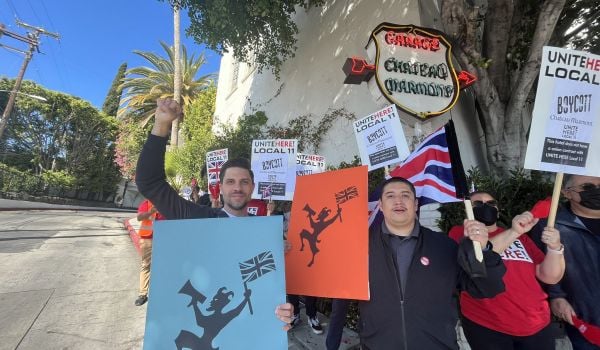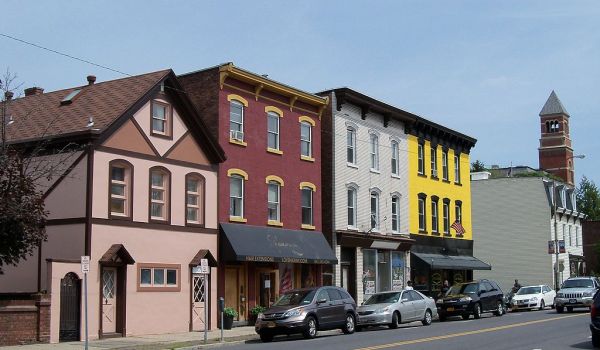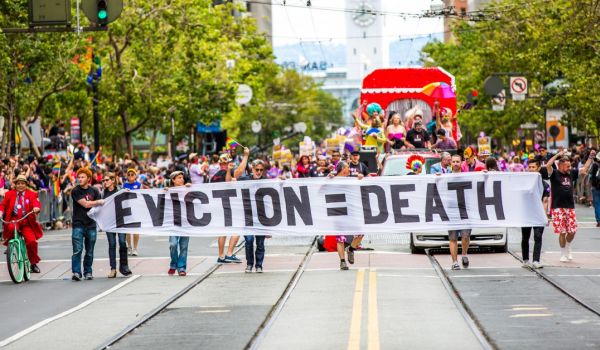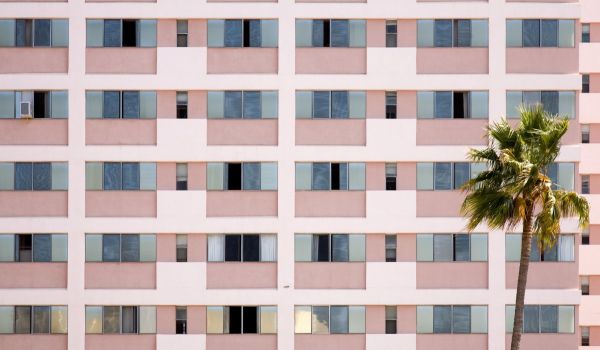This article was co-published by Prism and Next City as part of our Solutions for Economic Equity partnership, highlighting how low-income and marginalized BIPOC communities are cultivating, building and seizing economic justice in cities across the U.S.
For the wealthiest state in the nation, California’s social and economic inequality is glaringly stark. More than half of America’s unhoused population lives there, and it’s the only state where more than 70% of that population is unsheltered—that is, living outside the shelter system in tents, informal communities, and camps—The Guardian reported. And nowhere in the state is the disparity so affronting as in Los Angeles, among the ten wealthiest cities in the world and also home to the largest unsheltered population of any U.S. city.
But it isn’t as inexplicable as it outwardly appears, nor is it as intractable as many would believe, houselessness advocates say. By now, the main driver of this public health and human rights crisis there should be apparent: While too many are quick to dismiss houseless neighbors (“homeless” is often considered a slur) as mentally ill or suffering from substance use issues—which is the reality for many living on LA’s streets—the crisis is decades in the making due largely, advocates say, to a lack of affordable housing.
The city builds fewer new homes per capita than almost any American city, and as rent continues to spiral unabated, the compounding conditions are producing a steady stream of Angelenos being pushed into houselessness.
Low-income housing is scarce, but of the accommodation being built, it’s perhaps not as prioritized as more expensive and revenue-generating projects. The number of people being pushed out of their homes—as well as the escalating wrath of NIMBYs—outpaces the number of affordable housing units being built.
To properly respond to the crisis, advocates say, government officials need to address the issue at both ends: how to get unhoused neighbors into housing and how to keep the people teetering on the edge of houselessness in their homes. So far, neither the city nor county have managed to solve for either.
Political stunts
The city’s manifold attempts to address houselessness are part of a long and checkered history of short stints, false starts, quick fixes, and displaced blame. Perhaps its most common—and aggressive—strategy employed today is encampment “sweeps,” or the forcible removal of unhoused persons from public spaces like sidewalks by the city’s sanitation department, law enforcement, and outreach workers. During the pandemic, even as CDC guidance recommended that encampments not be disturbed to avoid transmission of the virus, LA city council voted to resume sweeps anyway.
Advocates say that sweeps serve a greater purpose as political stunts than an actual response to addressing this crisis, and as midterms near, elected leaders and candidates alike feel the pressure to prove to voters that they’re fit to take action.
Billionaire real-estate developer Rick Caruso, a front-running mayoral candidate, wants greater police presence and 1,500 more officers for the LAPD, in addition to more shelter beds. His opponent, Congresswoman Karen Bass, wants to leverage existing city funds and bring in federal government resources to address the issue.
Both have supported cosmetic quick fixes as well: In August, they supported an expansion of city ordinance 41.18, which bans individuals from sitting, lying or sleeping within 500 feet of schools and daycare centers. Superficially, the move appears rational—if we are to believe that all unhoused people are dangerous.
Prevailing stereotypes of unhoused neighbors often act to put as much distance between their circumstances and our own, relying on the idea of meritocracy to suggest that unhoused people somehow earned, or deserved, their own misfortune. But the truth of the matter is that many are students living in their cars because the expenses of higher education are too high; seniors and disabled people who can no longer afford the long-term care that they need; families with children; and people currently or recently employed in both part and full-time work.
On the ballot
This November, Angelenos will have the chance to vote on what could be one of the boldest responses to the crisis to date. Measure ULA, or “United to House L.A.,” is perhaps best known as the “mansion tax,” a documentary transfer tax that would impose a one-time 4% tax on property sales above $5 million, rising to 5.5% on transactions above $10 million.
The funds generated would not only fund development of additional low-income housing units and their administration, but it would also support renter protections that could prevent people from being pushed into houselessness in the first place—about 30% would go to funding short-term emergency rent subsidies for at-risk households, direct payments to seniors and disabled people, and tenants’ right to counsel.
“It takes money exactly from the place that it should be money—that is, from mostly corporations, but also certain individuals, who are profiting the most from this unsustainable housing market,” says Alexandra Suh, executive director of the Koreatown Immigrant Workers Alliance (KIWA) and a key member of the multiracial coalition behind the measure, also called United to House L.A. “No one else is paying any of this new tax. And it’s going to go towards a whole range of solutions.”
Rather than a bond measure, Measure ULA would provide a dedicated ongoing revenue stream, generating an estimated $600 million to $1.1 billion a year, according to a city analysis.
“It’s a perpetual source of income,” said Suh. “As long as there are properties being sold or 5 million and up, there will be a source of funding for this program.”
One of the main criticisms of the measure, adopted by mayoral candidate Bass, is that the city already has sufficient funds allocated toward affordable housing for the unhoused population, but the units weren’t being built quickly enough, not only to meet the pace of the demand but also to match the initial projected costs of construction, which often increased mid-project.
That argument cites one of the measure’s predecessors, Proposition HHH—the $1.2 billion bond for permanent supportive and affordable housing approved by voters in 2016—which is actually set to meet its goal of 10,000 new units in 10 years, but the need today now exceeds that goal. Mayoral candidates have criticized it for its delays and high costs. Neither Bass nor Caruso appear to support Measure ULA.
Its proponents claim that it addresses the shortcomings of measures before it by funding eviction prevention efforts to stem the flow of residents being forced into houselessness, and by purchasing existing buildings to use as housing.
“What past measures tell us is not that they’ve been abject failures,” says Suh. “It’s that they’ve done some good, but we need to do more.”
And, unlike the solution to houselessness before it, which have been historically “color blind,” Suh assures that a racial analysis was applied to the measure.
“The programs and policies funded through this initiative will be deployed in such a way as to address racial segregation, dismantle racially exclusionary practices, and promote racial equity in housing, academic, and economic opportunities,” the measure reads.
It has found supporters among The Los Angeles Times, the ACLU of Southern California, the Sunrise Movement, United Teachers Los Angeles, and the LA chapter of The Alliance of Californians for Community Empowerment (ACCE) Action.
Who are the unhoused?
For those pushed into houselessness who were currently or recently employed, their average annual earnings were only $9,970, according to a study by the California Policy Lab. The average rent for a one-bedroom apartment in Los Angeles is $2,807 a month, or more than $33,600 a year.
“We see the driver of homelessness as the unsustainable housing market in Los Angeles,” says Suh. “And that problem will only be solved when we’re able to address the housing crisis in our city.”
Many advocates had hoped that the pandemic would be the catalyst the city needed to disrupt the status quo and house those in need without conditions, caveats, or restrictions. And, to a limited extent, it did.
The state established a promising program called Project Roomkey, designed to house medically vulnerable unsheltered people in hotel rooms left vacant by hollowed tourism. But city officials were challenged with securing rooms, even from hotels that had received taxpayer subsidies—some citing their concerns that participation in the program would “affect its brand.”
The program did manage to court some hotels, but, like other measures implemented to keep unhoused people safe during the pandemic, it wound down before hitting its target—and at the peak of a countywide Covid surge no less. All said and done, Project Roomkey sheltered some 10,000 people in Los Angeles, less than half of whom went on to secure permanent housing.
Nor did the response address the issue at both ends. Even as pandemic-related emergency tenant protections were installed, houselessness still steadily rose across the state, which experts attribute to lost earnings among Californians who were already living paycheck to paycheck.
Los Angeles has the second-priciest housing market in the country, so residents mostly rent. And with a housing shortage, rent here is 134% higher than the national average, so the average renter pays 45% of their income to housing, compared to the national average of 25%. Many were a hair away from houselessness before the pandemic, and those who didn’t qualify or didn’t receive those protections in time were then pushed into shelters or onto the street. What’s more, the city council recently voted to end the pandemic-related eviction moratorium on February 1, 2023, which puts those who were thrown a lifeline by those protections will now be at risk of houselessness.
Politicians and outreach workers alike habitually have beat the drum for more shelters, but that response isn’t exactly the godsend that housed people may believe it is (at least the ones who support having shelters to begin with). Those actually entering the shelter system are subject to curfews and other restrictions that Theo Henderson, creator of the We the Unhoused podcast, has likened to jail.
“It’s basically coddling housed people’s visions of who unhoused people are,” says Henderson, who has eight years of unhoused experience before recently securing housing. “They’re always trying to say that unhoused people don’t want help, but when we say we do, they will refer to some carceral solutions like shelters, and when unhoused people turn that down, they will say that we’re ungrateful for just basic care.”
Henderson pointed to other ways that solutions to address houselessness are driven more by placating housed residents than actually serving unhoused people. Even organizers working in this space, he says, have been woefully inconsiderate of a critical—yet too often dismissed—part of the conversation concerning houselessness in this city: race.
Communities of color are disproportionately impacted by gentrification, the process of which includes overpolicing and criminalizing them before displacing them outright. The same phenomenon is observed in the unhoused population’s interactions with law enforcement, where again, race is an immovable factor.
Black Angelenos are overrepresented among the unhoused: One in 33 Black Angelenos will experience houselessness at some point in their lives, compared to one in 250 white Angelenos
“As a person of color—as a Black man in a society deeply entrenched in white supremacy—we always have to gatekeep or spar with outsiders or interlopers who are trying to override our issues and oppression by saying that they know better than us,” says Henderson. “There are organizations that have been using white supremacist organizing tactics, and these organizations use other people of color organizations to run interference [so that they can] obfuscate issues of white supremacy in the organization and avoid accountability.”
It’s a pervasive issue observable across the nonprofit landscape: 80% of nonprofits are white-led, providing services to “disadvantaged communities” that are predominantly Black and brown.
“I do think that, for reasons that are entirely structural, when we look at who has decades of expertise in housing policy and economic analysis, we see the same kind of racial structure replicated that we do anywhere else in society,” says Suh. “People tend to reach out to people who are already strong in that area. And a in a white-dominated society, it tends to be more of white-dominated organizations. It’s just very, very established, and we have to mindfully create space for ourselves and our allies.”
Henderson had never heard of the measure before our call. When asked if unhoused stakeholders were part of the drafting of this measure, Suh says that some member organizations working directly with unhoused people consulted them in this process. The measure appears to provide a full-spectrum response to the crisis, but, Suh says, it also has the flexibility to adapt its strategy in how it applies its solutions, including based on community feedback—and certainly feedback from the unhoused.
“We don’t imagine that Measure ULA is a magic wand that’s gonna suddenly fix everything,” says Suh. “But we do see it as the most ambitious, far-reaching, and comprehensive solution that we’ve seen.”

Frances Nguyen is a freelance writer, editor of the Women Under Siege section (which reports on gender-based and sexualized violence in conflict and other settings) at the Women's Media Center, and a member of the editorial team for Interruptr, an online space for women experts to disrupt discourse in traditionally male-dominated focus areas. She is currently working on a creative nonfiction portfolio on race, identity, and the American Dream.

